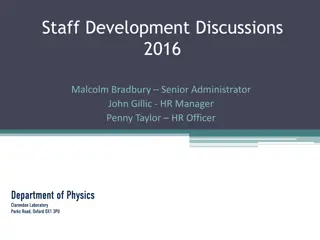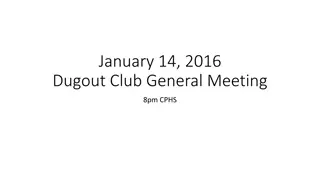
Evaluating Performance in DPMAP Rev.2 July 2016
"Learn about evaluating performance in the Defense Performance Management and Appraisal Program (DPMAP) Rev.2 July 2016. Understand the importance of employee inputs, preparing for performance discussions, and the rating system used. Ensure a fair and transparent appraisal cycle with no surprises at the end."
Download Presentation

Please find below an Image/Link to download the presentation.
The content on the website is provided AS IS for your information and personal use only. It may not be sold, licensed, or shared on other websites without obtaining consent from the author. If you encounter any issues during the download, it is possible that the publisher has removed the file from their server.
You are allowed to download the files provided on this website for personal or commercial use, subject to the condition that they are used lawfully. All files are the property of their respective owners.
The content on the website is provided AS IS for your information and personal use only. It may not be sold, licensed, or shared on other websites without obtaining consent from the author.
E N D
Presentation Transcript
Lesson 6: Evaluating Performance DPMAP Rev.2 July 2016
DPMAP Rev.2 July 2016 No surprises for either party at the end of the appraisal cycle (2)
Learning Objectives Upon completionof this lesson, you will be able to: Recognizeimportant facets of the Evaluating Phase. Describe how employees inputs benefit the final performance appraisal discussion. Explain how to prepare for the performance discussion. DPMAP Rev.2 July 2016 No surprisesfor eitherpartyat the end of the appraisalcycle (3)
Performance Management Ongoing Supervisors and employees share responsibility Consist of: PLANNING Proactively planning work and setting expectations Continually monitoring performance Evaluating performance in a summary fashion Recognizing and rewarding good performance PERFORMANCE EVALUATING MONITORING MANAGEMENT RECOGNIZING AND REWARDING DPMAP Rev.2 July 2016 No surprises for either party at the end of the appraisal cycle (4)
Evaluating Performance Evaluating Performance Evaluating performance entails assessing performance against the performance elements and standards in the employee s approved performance plan and assigning a rating of record based on work performed during the appraisal cycle DoD Instruction 1400.25, Vol. 431 DPMAP Rev.2 ly 2016 Ju No surprises for either party at the end of the appraisal cycle (5)
Evaluating Performance Prepared and documented in the MyPerformanceToolon DD 2906 Employee Input Performance Appraisal Cycle: 1 Oct 30 Sept PERFORMANCE APPRAISAL Performance Ratings 5 - Outstanding 3 - Fully Successful 1 - Unacceptable Employee Performance Performance Rating Narrative DPMAP Rev.2 ly 2016 Ju No surprises for either party at the end of the appraisal cycle (6)
Employee Performance Ratings At the end of the appraisal cycle, an employee s performance is rated by his or her supervisor against the employee s performance plan (5) OUTSTANDING The average score of all performance elementratings is 4.3 or greater, with no elementbeingrated a 1 , resultingin an overall ratingof record that is a 5 . (3) FULLY SUCCESSFUL Employee must be provided a written rating of record and been under an approved performance plans for 90 calendardays during the The average score of all performance elementratings is less than 4.3, with no elementbeingrated a 1 , resulting in an overallrating of record that is a 3 . (1) UNACCEPTABLE Any performanceelementrated as a 1 . DPMAP Rev.2 ly 2016 Ju No surprises for either party at the end of the appraisal cycle (7)
SAMPLE Performance Rating Narratives Level 5 - Outstanding Level 3 Fully Successful Level 1 - Unacceptable Producesexceptionalresultsor exceedsexpectationswell beyondspecifiedoutcomes Sets targetedmetrics high andfar exceedsthem(e.g., quality, budget,quantity) Handlesroadblocksor issues exceptionallywell andmakesa long-termdifferencein doingso Is widelyseen as an expert, valued rolemodel,or mentorfor this work Exhibitsthe higheststandardsof professionalism Effectivelyproducesthe specified outcomes,andsometimes exceedsthem Consistentlyachievestargeted metrics Proactivelyinformssupervisorof potentialissuesor roadblocksand offerssuggestionsto addressor preventthem Achievesgoals withappropriate level of supervision Doesnot meet expectationsfor qualityof work;fails to meet manyof the requiredresults for the goal Is unreliable;makespoor decisions;misses targeted metrics(e.g., commitments, deadlines,quality) Lacks or fails to useskills requiredforthe job Requiresmuch more supervisionthanexpectedfor an employeeat this level DPMAP Rev.2 ly 2016 Ju No surprises for either party at the end of the appraisal cycle (8)
Evaluating Phase Roles and Responsibilities Employees Provide input Include each performance element Restate understanding of these performance elements Highlightall of the most significant achievements Make the connection accomplishment > result > impact on the organization Note challenges, how they were resolved, and lessonslearned Supervisors Request and consider employee input Consider obstacles encountered and overcome Prepare a written narrative and rating on each performance element Make meaningful distinctionsbased on performance; foster and reward excellent performance; address performance issues Clearly communicate approved and finalized ratings DPMAP Rev.2 ly 2016 Ju No surprises for either party at the end of the appraisal cycle (9)
Employee Input and Supervisor Evaluation Employee Input SupervisorEvaluation Written by employees about themselves Written by supervisors about employee performance Compares performance during the appraisal cycle to performance elements and standards Compares employee input, if completed, and performance elements and standards Provides opportunity for employee to state accomplishments and impact Provides employees with meaningful, constructive, and candid feedback Focuses on employees perception of their strengths and improved performance Focuses on supervisors assessment of strengths, improvement notes, and areas for improvement Emphasizes organizational impact of performance Emphasizes organizational impact of performance Makes supportable distinctions in performance above Fully Successful level (if applicable) Makes meaningful distinctions in performance and provides supporting documentation of the recommended rating (if applicable) Includes observations made by other managers, supervisors, customers, or peers Includes awards, recognitions, and compliments received during the appraisal cycle DPMAP Rev.2 ly 2016 Ju No surprises for either party at the end of the appraisal cycle (10)
Preparing for Performance Discussions Conducting successful performance discussions requires preparation Supervisors may use the following steps to prepare: Gather the material Review and write Schedule the meeting DPMAP Rev.2 ly 2016 Ju No surprises for either party at the end of the appraisal cycle (11)
Gather the Material Have all the necessary tools close at hand before starting to write the performance discussion narrative. This includes: A copy of the employee's performance plan Notes of previous meetings Employee input documents Written or recorded feedback on employee performance from other sources Gather the material Reviewand write Schedulethe meeting DPMAP Rev.2 ly 2016 Ju No surprises for either party at the end of the appraisal cycle (12)
Review the Material When writing the narrative, supervisors should consider: Responsibilities and Duties Performance Developmental Needs Review and write Gatherthe material Schedulethe meeting DPMAP Rev.2 ly 2016 Ju No surprises for either party at the end of the appraisal cycle (13)
Write the Performance Narrative Supervisors write a performance narrative that describes the employee s performance measured against the performance standards for the appraisal cycle Performance narratives : A written rating of record must be provided at the end of the appraisal cycle for each employee who has been under an approved performance plan for 90 calendar days during the cycle. Justify how an employee s ratings are determined Are required for each Performance Element Review and write Gatherthe material Schedulethe meeting DPMAP Rev.2 July 2016 No surprises for either party at the end of the appraisal cycle (14
Schedule the Meeting When scheduling performance discussions, supervisors set the date, time, and location of the meeting with the employee Note: Per DODI 1400.25, volume 431, a rating record of Unacceptable must be reviewed and approved by a higher level reviewer. Supervisors should be sure to familiarize themselves with and follow local policy before they communicate the rating to an employee. Supervisors should contact their Employee Relations Specialist in Human Resources prior to rating an employee as Unacceptable. Schedulethe meeting Gatherthe material Review and write DPMAP Rev.2 ly 2016 Ju No surprises for either party at the end of the appraisal cycle (15)
Performance Discussions DPMAP requires three performance discussions between supervisor and employee during the performance appraisal cycle. THEY ARE: Initial Performance Planning Meeting Final Performance Appraisal Discussion Progress Review In addition to those required, more frequent and meaningful periodic discussions between supervisors and employees are HIGHLY encouraged. They help to: Understand expectations toward goals Facilitatesupervisor-employee engagement Increase the amount of feedback Contribute to a more complete and accurately documented appraisal Encourage supervisors to recognize and reward deserving employees in a more timely manner All performance discussions should be given sufficient, uninterrupted time, in a suitable private location, and results documented DPMAP Rev.2 ly 2016 Ju No surprises for either party at the end of the appraisal cycle (18)
Resolving Differences A rating of record is official even if the employee does not sign it If possible, differences should be resolved informally If they cannot be resolved, the employee: May raise issues related to the performance appraisal process through the administrative grievance system or, where applicable, the negotiated grievance procedure Has the right to appeal performance- based actions Title 5, Code of Federal Regulations 432 and 752 DPMAP Rev.2 ly 2016 Ju No surprises for either party at the end of the appraisal cycle (19)
Learning Objectives Review You should now be able to: Recognize important facets of the Evaluating Phase. Describe how employees inputs benefit the final performance appraisal discussion. Explain how to prepare for the performance discussion. DPMAP Rev.2 ly 2016 Ju No surprises for either party at the end of the appraisal cycle (20)
Questions? Are there any questions? DPMAP Rev.2 No surprisesfor either partyat the end of the appraisalcycle Ju ly 2016 (21)
Additional Resources DODI1400.25,Volume 410, DoDCivilian PersonnelManagementSystem: Training, Education,andProfessionalDevelopment. DODI1400.25,Volume 431, DoDCivilian PersonnelManagementSystem: PerformanceManagementand AppraisalProgram. DODI1400.25,Volume 451, DoDCivilian PersonnelManagementSystem: Awards. DCPAS Resources and References web site includes: DCPAS HR Toolkit, Tip Sheets and Checklist, MyPerformance Training Videos, and MyPerformance User Guides https://www.cpms.osd.mil/Subpage/NewBeginnings/ResourcesReferences/ DCPAS LERD web site https://dodhrinfo.cpms.osd.mil/Directorates/HROPS/Labor-and-Employee- Relations/Pages/Home1.aspx Corporate Leadership Council. Building the High-Performance Workforce: A Quantitative Analysis of the Effectiveness of Performance Management Strategies(WashingtonD.C.:Corporate Executive Board, 2002) DPMAP Rev.2 ly 2016 Ju No surprises for either party at the end of the appraisal cycle (22)















